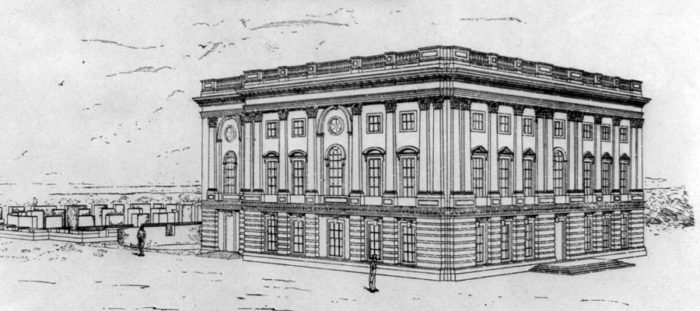 I have often written of travel guides of Washington, and have tried to find ever earlier attempts to describe the city. I may have come upon the earliest of all.
I have often written of travel guides of Washington, and have tried to find ever earlier attempts to describe the city. I may have come upon the earliest of all.
Christoph Daniel Ebeling, born in Germany in 1741, became intrigued by the North American continent while studying theology at Göttingen University. While he thereafter became a teacher, including long stints at two high schools in Hamburg, he eventually had to give up this field of endeavor in 1799 due to increasing deafness. He thereafter worked as a librarian. However, before taking up this new task, he completed what would be his magnum opus: a seven volume account of the United States. The first, covering New Hampshire and Massachusetts, came out in 1793. The fifth one, covering Delaware and Maryland, would follow six years later. It is this one that includes a description of city of Washington, and the “District or the Territory of Columbia.”
Ebeling spends 40 pages describing the new capital city, an achievement especially impressive when one realizes that he spent no time whatsoever in the city. In fact, it appears that he never set foot on the North American continent, but instead used other sources to supply the facts for his book.
This becomes apparent in the eight pages that he uses to describe the layout of the city. It is a perfectly decent attempt to set down the plan in words, but occasionally it is clear that he is not working from the reality on the ground, as when he describes the state squares:
From the other large reservations in the city, which are created by the intersections of the main streets, 15 are assigned to the individual States, and are named Massachusetts Square, Vermont Square, etc. They are to be used for statues of the famous and important men from that states.
This notion was indeed set down in the L’Enfant plan, but nothing ever came of it. It appears that Ebeling simply took the original plan and converted it into prose.

The Capitol as it looked in 1800. (LOC)
Of the Capitol, Ebeling writes, correctly, that only the north wing was complete at the time, and that it stands on “the leveled area of Jenkins Hill, or, as one now sadly refers to it, Capitol Hill.” While most of the description fits with what local observers wrote at the time, his attempts to explicate the interior seems to fall a bit short:
Below is the large, magnificent hall for the House of Representatives, while above is another of the Senate. Both are decorated with columns, and the lower has a gallery for visitors.
In fact, the House of Representatives had no room to call their own when they arrived in Washington in 1800, and had to beg for the use of one in the Senate’s wing – a room that was actually on the floor above that of the Senate. Later, when the House wing was eventually built, their chamber was on a level above that of the Senate, prompting the Senate to raise the floor of their hall so that they would not be below their colleagues on the other side.
Over the next few weeks, I will look at other ways Ebeling described – and misdescribed – the Capitol Hill neighborhood.
